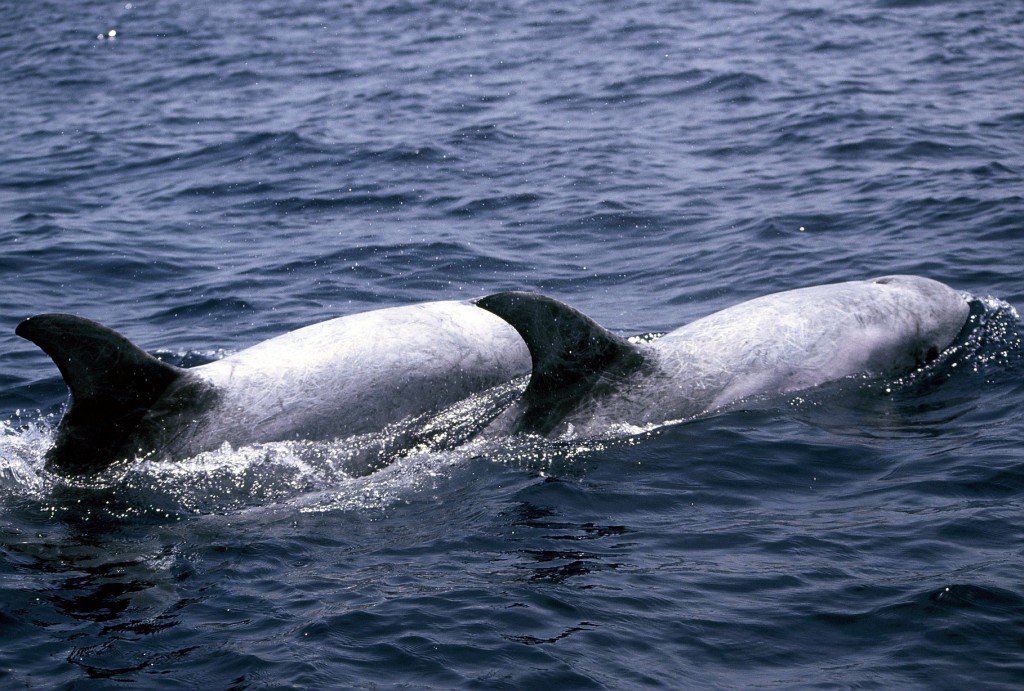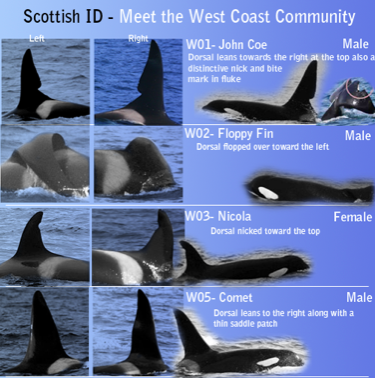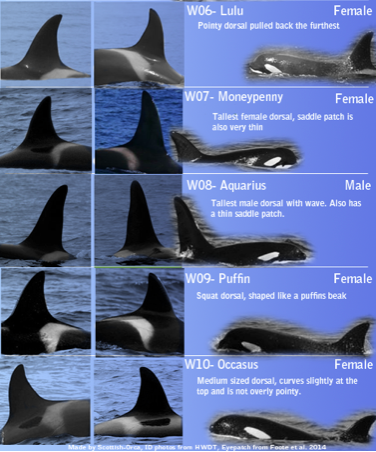You might have heard about the West Wales killer whale sighting posted on Facebook last week? There were three separate potential sightings of this magnificent species in Cardigan Bay off the coast of Mwnt, seen from land as well as from sea. One such anecdotal report was from a couple to the owner of the B&B where they were staying. They were out walking and reported seeing a black fin that wasn’t similar to a dolphin-fin shape. Although this and the other reports could not be confirmed, Razorbill SeaSafari went out from Cardigan in an attempt to verify the identification but did not manage to catch up with any killer whales.
As awesome as it would be spotting killer whales in Cardigan Bay, people might have confused it with similar species. The species that are most likely to be confused with killer whales locally, are Risso’s dolphins. So, how to tell them apart? It mostly comes down to different colouration patterns: Risso’s dolphins are usually pale grey with lots of scars that they get from fighting among themselves. Young individuals however are not as scarred as older ones and can be quite dark. Risso’s dolphins reach up to 4 metres in length compared to 6-7 metres in killer whales. In rough conditions which are quite normal in British waters, it can be difficult to distinguish species, especially from land. In such conditions, even bottlenose dolphins can look pretty dark and large and might be confused for a killer whale or other cetacean species.
Risso's dolphins by Daphna Feingold/ Sea Watch Foundation
Killer whales are occasionally seen in Welsh waters including Cardigan Bay. Usually sightings are offshore west of Pembrokeshire, but in 2010 one was seen near Criccieth on the Llyn Peninsula, and there have been unconfirmed records in that area since.
Contrary to popular belief, no killer whales around the British Isles can be considered truly resident. They all can travel great distances from one month to the next and even one day to the next. Nevertheless, they do have favoured locations where recognisable individuals return year after year. West of the British Isles, one such favoured haunt is the Sea of Hebrides, from the Isle of Skye south to Barra in the west and Islay in the east. This community (often referred to as the West Coast Community) appears to be quite small, numbering up to 14 animals. A few years ago a calf was seen in the pod but otherwise reproduction appears to be at a very low rate.
In the North Sea and Northern Isles live a much larger community (often referred to as the Northern Community) with pods that may intermix with one another, particularly in winter when up to one hundred animals have been seen offshore associating with purse seine trawlers as they haul their nets for herring or mackerel. These whales appear to belong to a population that also inhabits Icelandic and Norwegian waters. In coastal UK waters, favoured haunts include around the Shetland Isles, Fair Isle and Orkney south to Caithness and the outer Moray Firth.
Perhaps the best known killer whale is Britain is a mature male that we nicknamed “John Coe” after a character in a poem that wandered the oceans. We first saw him back in 1980 so he is definitely well over 35 years old, and could be twice as much (killer whales are known to live c. 90 years). He is recognisable by a distinct cut near the base of the dorsal fin. John Coe has been seen many times in the Hebrides, but lives up to his name ranging as far as Co. Galway in Western Ireland, the Pembrokeshire coast in SW Wales, and the Outer Moray Firth in NE Scotland. Sightings in the latter location highlight the fact that individuals from these two communities are not strictly separated geographically. If these recent sightings off Wales should indeed have been a killer whale, reports in the media have suggested that it could have been John Coe, having been seen off Pembrokeshire in the past though usually in company of some females from his pod and in deeper offshore waters.
Killer whales by F Ugarte/ Sea Watch Foundation
In coastal waters of Britain and Ireland, most sightings of killer whales are in summer between May and September. Some coastal sightings appear to be associated with when seals aggregate before breeding (harbour seals breed mainly in June and Atlantic grey seals in September to December). It has been suggested that different killer whale pods specialise either on fish or marine mammals. However, we have seen individuals in the Hebrides moving from feeding on herring within hours to chasing harbour seals.
Our National Whale and Dolphin Watch finished yesterday, but we’re always interested in adding your sightings to our national database so keep your eyes peeled wherever you are around the UK… and keep an extra special eye out for them around Mwnt and along the coast of Wales because maybe we’ll get a confirmed killer whale sighting in this area!! Feel free to submit a sighting on our website or just send an email. Any pictures will be highly appreciated as they help a lot in identification.
So give it a go and don’t forget – Observe – Record – Report!
Figure 1 shows an identification guide for the West Coast Community where you can see differences in their fins, saddle patches and eye patches. (from http://scottish-orca.tumblr.com/tagged/fff)




























